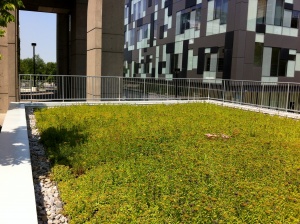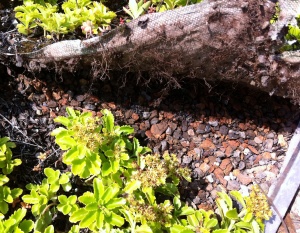Difference between revisions of "Green roofs: Performance"
Jump to navigation
Jump to search
Jenny Hill (talk | contribs) (Created page with "thumb|Recently laid ''Sedum'' mats on a ground level podium roof. File:YorkU2.jpg|thumb|Detail showing the early root development through the mat to the...") |
(No difference)
|
Revision as of 01:50, 9 November 2017
Green roof performance has not been reported to reduce over time. Controlled studies have instead indicated that maturing green roofs may have improved water retention properties [1].
The key hydrologic benefit which green roofs have over other forms of LID is the proportion of the water returned to the atmosphere through evapotranspiration.
- In Southern Ontario rainwater retention of extensive green roofs without irrigation is between 60% and 70%[2][3][4].
- Including winter periods with snow accumulation and thaw, the annual retention of extensive green roofs is around 50% [5][4].
- Using a compost based planting medium improves retention by around 10% i.e. 60 % for compost compared to 50% for granular.
- Daily irrigation can reduce the annual retention by 20% compared to a roof without irrigation. i.e. 40% for irrigated compared to 60% without irrigation[4]. However, recirculating rainwater from a cistern was estimated to double the annual retention in Florida[6]. The research team modeled 87% retention for a green roof coupled with a cistern, compared to 43% for the green roof alone.
An appropriate NRCS curve numbers for green roofs without irrigation in Southern Ontario is 90 [7][8].
- ↑ http://www.sciencedirect.com/science/article/pii/S0022169417300768
- ↑ http://www.sustainabletechnologies.ca/wp/wp-content/uploads/2013/03/NRC_EastviewGRrept.pdf
- ↑ http://www.sustainabletechnologies.ca/wp/wp-content/uploads/2013/03/GR_york_fullreport.pdf
- ↑ Jump up to: 4.0 4.1 4.2 Hill J, Drake J, Sleep B, Margolis L. Influences of Four Extensive Green Roof Design Variables on Stormwater Hydrology. J Hydrol Eng. 2017;22(8):04017019. doi:10.1061/(ASCE)HE.1943-5584.0001534
- ↑ http://www.sustainabletechnologies.ca/wp/wp-content/uploads/2013/03/GR_york_fullreport.pdf
- ↑ http://www.mdpi.com/2073-4441/4/4/914
- ↑ Curve Number and Runoff Coefficients for Extensive Living Roofs Elizabeth Fassman-Beck, Ph.D., A.M.ASCE; William Hunt, Ph.D., P.E., M.ASCE; Robert Berghage, Ph.D.; Donald Carpenter, Ph.D., P.E., M.ASCE; Timothy Kurtz, P.E., M.ASCE; Virginia Stovin, Ph.D.; and Bridget Wadzuk, Ph.D., A.M.ASCE
- ↑ Hill J, Drake J, Sleep B, Margolis L. Influences of Four Extensive Green Roof Design Variables on Stormwater Hydrology. J Hydrol Eng. 2017;22(8):04017019. doi:10.1061/(ASCE)HE.1943-5584.0001534

